
The Best Bones For Broth + How to Make it in 3 Steps
Finding The Best Bones For Broth
The number one key to gelatinous and flavorful broth is using the best bones.
If you don't find the right bones then you risk making a bland liquid that isn't good for cooking or sipping.
By following the exact tips in this article you'll have a concentrated broth for any occasion. I'm going to show you how to get these bones and which ones to select. Also, which ones do not work at all.
First a quick note: my company makes and sells the most delicious bone broth powder for cooking for drinking on it's own.
So if you can't find bones or are sick of making it yourself, give Bluebird Provisions a try.
Now let's get onto the information you want.
The Health Benefits of Broth
The health benefits of broth are that it is full of nutrients we lack in our western diet for hair growth, skin health, restoring digestion, helping you sleep, controlling your blood sugar and reducing joint pain.
The reason for these benefits are collagen protein, which is made up of crucial amino acids like glycine, proline, glutamine and glucosamine. Let's discuss each of these briefly.
Minerals For Restoring Digestion
The amino acids in it (glycine and proline) are shown to help repair small holes in your intestines. We get these holes from eating food we are sensitive to, but sometimes do not know it.
If untreated, these can lead to health problems like stomach pain, leaky gut, IBS / IBD, crohn's disease or ulcerative colitis.
Broth also stimulates digestive enzymes in your stomach to help prepare for incoming food. This relaxes your digestive system and lets it properly absorb nutrients from food.
Vitamins For Hair Growth
Because of collagen, it can help fill out cells, give skin a fuller appearance and improve the shine and quality of your hair, teeth and nails. The issue is that the research shows it can take 8 weeks to notice a difference.
Joint Pain
The collagen protein, glucosamine and chondroitin help stimulate new tissue growth around your joints while hydrating and lubricating them so that they can rebuild properly.
You are best to drink it before exercise (combined with vitamin C) to give your joints the nutrition when they need it most.

Sleep Benefits
Taking 3 grams of glycine (found in 1 cup of concentrated bone broth) before bed helps you get to sleep by decreasing your core body temperature. It also helps you get into deeper and more restorative phases of sleep.
Finally, it can help you relax and provide mental health benefits.
Skin Health Nutrients
It's is great for your skin because it is full of collagen, which helps to keep your skin elastic, hydrated and moisturized. It also contains glycine, an amino acid that helps rebuild new cells and tissue throughout your body.
The Best Bones to Make a Broth
The best bones for broth are full of connective tissue like joints or knuckle bones for beef and feet for chicken.
Think about getting the big joints responsible for moving animals around. These are feet, hips and knees.
That being said, the best bones are not always available. So the best for you are the ones that you can get access to.
Nowadays, it is not always easy to find the correct bones. I'll tell you the ideal bones to use, then some other suggestions and substitutes because some of them are had to find.
Soup and bone broth brands buy them all up before they even get to butcher shops or grocery stores.
Decide on Your Bone Broth Ingredients
Choose which type of beef, chicken, pork, seafood or game meat broth you want to make.
Beef broth and chicken broth recipes are popular choices. You can also include turkey, duck or lamb in your formula by using a mix of different bones.
Oftentimes the most flavorful broths are a mix of beef, chicken and pork. It takes some experimentation to figure out which tastes you enjoy. But I encourage you to try different animals.
Beef Soup Bones for Broth
The two most common types of beef bones are marrow and knuckle bones.
Marrow bones are the long and skinny bones that are located on the legs and arms of the cow.
Also referred to as "pipes," marrow bones consist of marrow in the middle, which models their shape.

You find them at butcher shops cut into 3 inch pieces. This is for good reason. Using the whole 8 inch long arm or leg bone will not make you a very good broth.
This is because we can't access the marrow or connective tissue for flavor and nutrition when it is not cut or processed down first.
Quality Beef Knuckle Bones
Knuckle bones is a term that refers to the joints of a cow. These are hips, knees, necks and feet.
The joints are responsible for moving cows in different directions, so they have more magical things that we need for broth compared to marrow bones.
What are these magical things you ask?

Cartilage and connective tissue. These areas of the bones have the most collagen and amino acids. They make for the best broth in terms of flavor and thickness. The picture above shows a knee joint -- perfect!
The best broth is made using a combination or knuckle and marrow bones. Marrow provides flavor, but often does not give you the same gelatinous nature and protein as knuckle bones.
A good ratio is around 70% knuckles and 30% marrows or pipes.
Oxtail or Beef Neck Soup
You can also use oxtail or short ribs to make broth or stock. Denser cuts of meat and bones have more cells per pound or kg than less dense areas.
This is what makes them tough, but it also means they are more nutrious parts of the animal because they have more connective tissue, collagen and glutamate. It just takes longer to break them down when cooking.
Best Chicken Bones
The best chicken bones for broth are feet, followed by wings and drumsticks in that order.
Feet give you a rich and flavorful broth that is almost impossible to do without them. They're full of glutamate which give you that natural umami flavor.
But much like beef, chicken broth is often made with a mix of poultry bones. This is usually for cost and availability reasons.

My company would use all feet in our organic chicken broth, but we can't get enough of them... and they're expensive.
Most of our usual suppliers tell me that they export all of them to Asia. So I don't even have the opportunity to buy them.
And if you do manage to find them in stores, they're usually on sale for $6.00 / lb or $14.00 / kg -- this is insane.
You can use approximately ⅓ feet to chicken backs (by weight) for a delicious broth. If you have more feet, just use all feet, but be careful of the following.
Chicken Feet Quality Issues
Be careful about buying chicken feet from just any supermarket. Chicken is a dirty industry, much worse than beef. They're kept in overpopulated barns with little space to move as they are fed antibiotics to grow quickly.
If you think about it, they are fed a lot and kept in barns with no space to move. But they have the defecate. Where do you think all of the poo goes?
Well... they stand in it for their whole lives. Oftentimes the ammonia in the poo burns their feet. These are unhappy chickens which produce unhappy feet.
Most of the feet are not fit for human consumption. Particularly in Canada, the CFIA makes chicken farmers dispose of the feet because of the awful living conditions.
The feet are burnt and disgusting. Not something you want to eat or use in broth. In other countries where the laws are not a strict, you'll see more feet in markets and in the food supply.
If you are going to use feet, make sure you inspect them first and ask about the sourcing. I would not trust anything that are not from non-GMO or organic sources. They should also have the toenails removed.
What can I substitute for chicken feet?
If you can't find chicken feet, don't worry, you can substitute wings, drumsticks and carcasses / backs and still make gelatinous broth. You'll need to use more poultry bones to water in your recipe.
Wings and drumsticks are seldom used, but they make fantastic stock. In this case, use half chicken carcasses and half wings / drumsticks by weight. Whole chickens (with meat on) work great as well.
How to Source the Right Bone Quality
Let's talk a bit more about bone quality because there are a lot of things to look out for both in terms of sourcing quality and bone quality.
For sourcing, opt for pasture raised and Non-GMO / Organic chicken bones. If they do not said non-gmo or organic, then they are definitely not.
Check for third party certifications like USDA Organic or Canada Organic to be sure.
For beef bones, opt for grass fed and / or grass finished. Beef does not necessarily need to be organic or non-gmo but it is certainly helpful.
You cant trust the sourcing of conventional beef much more than conventional chicken. Chicken is really an awful industry from an animal welfare, environmental and ethical perspective.
For this reason, I always recommend making beef stock first. Even if you buy conventional beef, it is still grass fed for 3/4 it's life. Many people do not know this but it's true.
How to Inspect Your Bones
You can inspect your bones by looking at them to see the quality. Particularly for beef this tells us the quality and how good they are for broth.
When frozen, look for red coloring on beef knuckle bones to tell the quality. Red tissue means a healthy animal, while yellow or darker colors mean the animal was not happy.
You also want knuckle bones that still have adhereing meat and connective tissue attached. Some processors cut all of this off, but you really want something that is not clean cut.
Marrow bones are more difficult to differentiate. So just buy whatever you can find.
Chicken bones can be inspected as well. For feet, look for clean feet that have toenails removed. Carcasses should ideally have some meat still remaining, although this is rare to find.
Where do I get bones for broth?
You can get bones for broth from your local butcher shop, grocery store, online or at farmers markets.
They're not as easy as they used to be to find because soup and broth brands are buying them up. This increased demand makes them more expensive too.

You can still find them if you look in the right places. Here are a few suggestions.
- Contact your local butcher or visit the freezer section of your grocery store. Ask if they can order them in for you – this is an easy solution often provided at stores.
- Butcher shops often have bones in the back. Sometimes they will even cut them down for you. Same goes for the meat departments of grocery stores.
- Farmers markets are another option. Ask farmers if they have bones for sale. Sometimes, they don't bother bringing them to the market because they're heavy and take up space. Oftentimes, they will bring you some the following week if you ask nicely.
- Many farmers are selling their product online, including bones. I have several trusted beef and lamb sources in Canada.
- CSA's or buying clubs allow you to purchase bones in bulk, which gives you the opportunity to negotiate better rates and share your prized bones with your friends.
When in doubt, buy directly from farms as this gives them more profit margin. Trust me, they need it.
If you roast chicken, don't throw away any leftover bones as you can use them in stock or soup recipes. They are great for making broth. If using raw chicken, mix raw bones with your soup or broth.
Roasting Bones for Stock
Roasting bones give you a deeper more caramelized taste that is impossible to get without roasting.
Some people prefer and some do not. It does not effect the nutrition, only the taste.
If you are going to roast them, then preheat your oven to 400 F and toss them on a large baking sheet.
For chicken you can drizzle extra virgin olive oil ontop then bake for 30 minutes.
For beef, you can coat the bones in tomato paste before roasting. This gives them a tremendous taste. You can also just use oil as well. Roast then for 40-50 minutes.
Blanching Bones: to Blanch or not to Blanch?
You don't need to blanch your bones. It is an unnecessary step that people who don't know what they're talking about tell you on the internet.
Much like apple cider vinegar myths, blanching is thought to remove impurities and give you more nutrition. It's a bunch of misinformation.
Skip the blanch in favor of a good, diligent skim during the first hour of your cook / boil for best results.
How to store it
Prepare your broth for optimal storage by first ensuring that you strain it properly.
Strain it using fine mesh or metal sieve or cheese cloth. This ensures you do not have any remaining solid bits in your broth.
Once you've strained it, you can store it for later use in airtight containers. Glass jars work great as do food grade zip pouches.
You can also use tupperware, but never reheat your broth within it as the plastic can leach harmful toxins into your body.
How long does bone broth last?
A large batch of broth can be stored safely in the refrigerator for 5 days or in the freezer for up to 6 months.
Sometimes I will store it in single serve size containers for ease of use in a stew recipe. Individual servings of broth can be frozen and reheated as needed.
My mom pours her broth into an ice cube tray, then freezes it for later use. She puts broth ice cubes into her smoothies for extra taste and hydration.
How much broth should you drink?
There is no firm recommendation for how much bone to drink. One cup per day is a good place to start, but you can drink more or less as needed.
A food-based medicine, like broth, is hard to overdose on. It is nutrients you get in daily life, but more of them.
If you're dealing with a flare up or looking to fix gut / digestion issues, then drink 3-4 cups per day on an empty stomach. It helps prepare your stomach acids to digest incoming food.
How much does it cost to make homemade broth?
It will cost you around $7 per cup to make a quality, homemade broth. Sounds crazy right? Not when we do the math.
Making homemade broth is more expensive than buying ready-to-drink broth. But it can still be worth it depending on the ingredients used and how much time is invested.
- Time to buy or assemble ingredients: 1 hour
- Prep time, skimming time, straining and storage time: 2 hour
- Cost of bones: $18 (3 lbs at $6 / pound)
- Cost of vegetables: $4
- Energy cost: $5
- Let's assume a 'wage' or cost for yourself at $20 / hour.
Your time is worth something, so we have to include it. I realize that this is conservative for some, ridiculous for others.
It is intended to make you think about the true cost of making things like broth.
- Total cost: $87
- Yield per average sized batch: 12 cups
- Cost per cup: $7.25
You might be better off purchasing a quality version that you can order online and get sent to your home.
Bluebird Provisions makes a great chicken bone broth powder for cooking and drinking. Save yourself some money and time and try some today.
What's the difference between stock and broth?
The main difference between stock and broth is that broth is cooked for at least 45 minutes to 2 hours while stock is cooked for 2-8 hours.
Stock may be used interchangeably with broth, but they have noticeable differences in flavor. Stocks are a bit stronger and more concentrated because they are cooked longer than broths. They're great for sauces.

Broth has lighter taste than stock or bone broth. Broth uses primarily meat while stock uses bones and scraps from the kitchen.
Other than that, they are somewhat similar. Learn all of the important differences in our primer on stock and broth vs. bone broth.
How to Make Broth in 3 Steps
You can make a simple and delicious broth for cooking or drinking by following three easy steps: roast your bones, simmer it low and slow, then strain and store for later use.
Sounds easy right? You'll see that there are some tricks of the trade, but nothing you can't learn from this article.
Step 1: Roast Your Beef Bones
Roasting your bones gives them a rich depth of flavor that is impossible to get without doing so.
For this reason, if you have time then always roast your bones. Grab a large roasting pan and lay your bones on it.
3 lbs of bones is a great starting point for homemade broth. It will make you 10-12 cups of finished broth.
For chicken bones you can drizzle some olive oil over them once they're on the pan.
For beef bones you can drizzle oil or coat with some tomato paste. The paste caramelizes while roasting which imparts an amazing taste.
Or you can simply just place the bones on a pan as is and roast them. Roasting bones ensures better flavor and a more potent bowl of broth.
Preheat your oven and roast the bones at 400°F for 35-50 minutes. Once finished roasting, simply place them into your stockpot, slow cooker and instant pot. Be sure to scrap all the bits from the pan into your pot.
Bones can be roasted ahead of time and then used for broth later on in the week or month.
Step 2: Simmer Under Medium Heat in a Stock Pot
- Add 12 cups of water to your stockpot. The bones should be submerged with an extra 2 inches or so of water. Not a ton more.
- Bring your pot to a boil over high heat. Once it boils, reduce to a rolling simmer. A common bone broth mistake is cooking it too low. You want this rolling simmer throughout the cook.
- Skim your broth for the first hour or so. Don't skimp on skimming or you risk getting cloudy broth.
- Do this 2-3 times. If you are adding vegetables and herbs, add them after you are finished skimming as the carbohydrates tend to get in the way. 1 onion, 2 carrots and 2 celery sticks is enough for this recipe.
- You can also add some garlic, ginger, parsley, rosemary and thyme. Thyme and rosemary only need a few springs.
- You can use 1/4 bushel of parsley. Simmer your broth for 1-3 hours. The longer you leave it, the better the flavor will be.
So don't be afraid to leave it on the stove all day to simmer away. You'll enjoy the nice smell in your kitchen and know you're making a quality cooking liquid for you and your loved ones.
Step 3: Strain and Store in Jars in the Fridge
Once finished, remove pot from your stove and prepare for straining. If you have a spider strainer, you can scoop the solids / bones out of the pot, making the pot easier to lift to strain it.
Then the stock is strained through a fine-mesh sieve after chilling. Compost your solids.
There may be some fat that will solidify at the top once it cools. It can be scooped off to use as cooking oil or mixed back in with the liquid.
The broth is easy to make and incredibly nourishing. There are many different variations of this basic recipe – some require chicken wings, pork bones or beef marrow bones.

The recipe does not require a pressure cooker, but it would be an excellent addition to the kitchen for those who want to use one. In this case, cook it on high for 60 minutes.
The fastest way to make homemade broth is with Bluebird Provisions Instant Bone Broth Powder.
Troubleshooting bland broth
Oh no, you have bland broth, there are some troubleshooting steps we can take? This could be for a few reason including cook time, bones to water ratio, heat, skimming and stirring. Let's discuss each below.
Apple cider vinegar is not needed as it adds unnecessary cost and does not add anything. You should also check my article on how to make bone broth taste better.
Cooking Time
You may have not cooked it long enough for deep, intense flavors to develop. Next time aim for 6 hours. There is really no upper limit to your cooking time. Just leave it on the stove all day to simmer away.
How to fix cloudy bone broth
There are times when homemade broth is milky or cloudy because of the fat and connectives in the bones cooks into the broth as it simmers.
This is usually because you did not skim it properly or enough or because you stirred your broth or moved the pot around too much.
Never stir your broth. Just leave it to simmer on it's own. The broth is still safe and delicious, it just may not look as appealing.
Bones to Water Ratio
This is the most common reason for bland or weak broth. For best results, you want 1.5:2 bone to water.
So if you're using 4 pounds of bones then you want 6 pounds of water (or 12 cups). That being said, if you have the correct bones, you can get this ratio closer to 1.2:2. Speaking of which...
Not Using The Right Bones
The right bones go a long way to making your broth bland or strong. As I mentioned above, you want the joints of knuckle bones for beef.
These are the primary movers and weight bearing bones that do the most work. As a result, they have the most collagen and connective tissue. For chicken, you want feet, wings and drumsticks.
These are responsible for helping chickens run around and fly, so they have the most collagen. Do your best to track these bones down next time for an irresistibly flavorful broth.

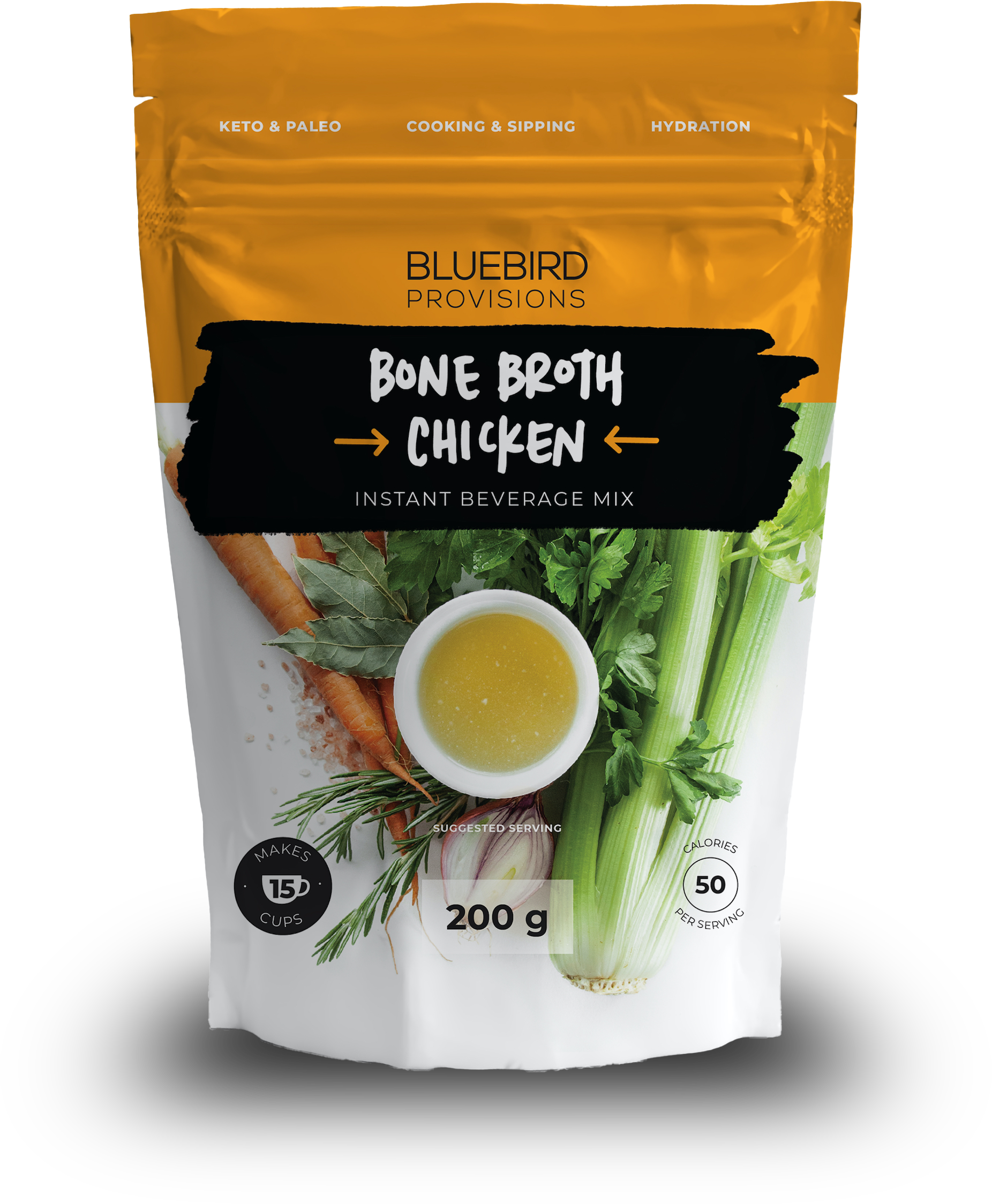

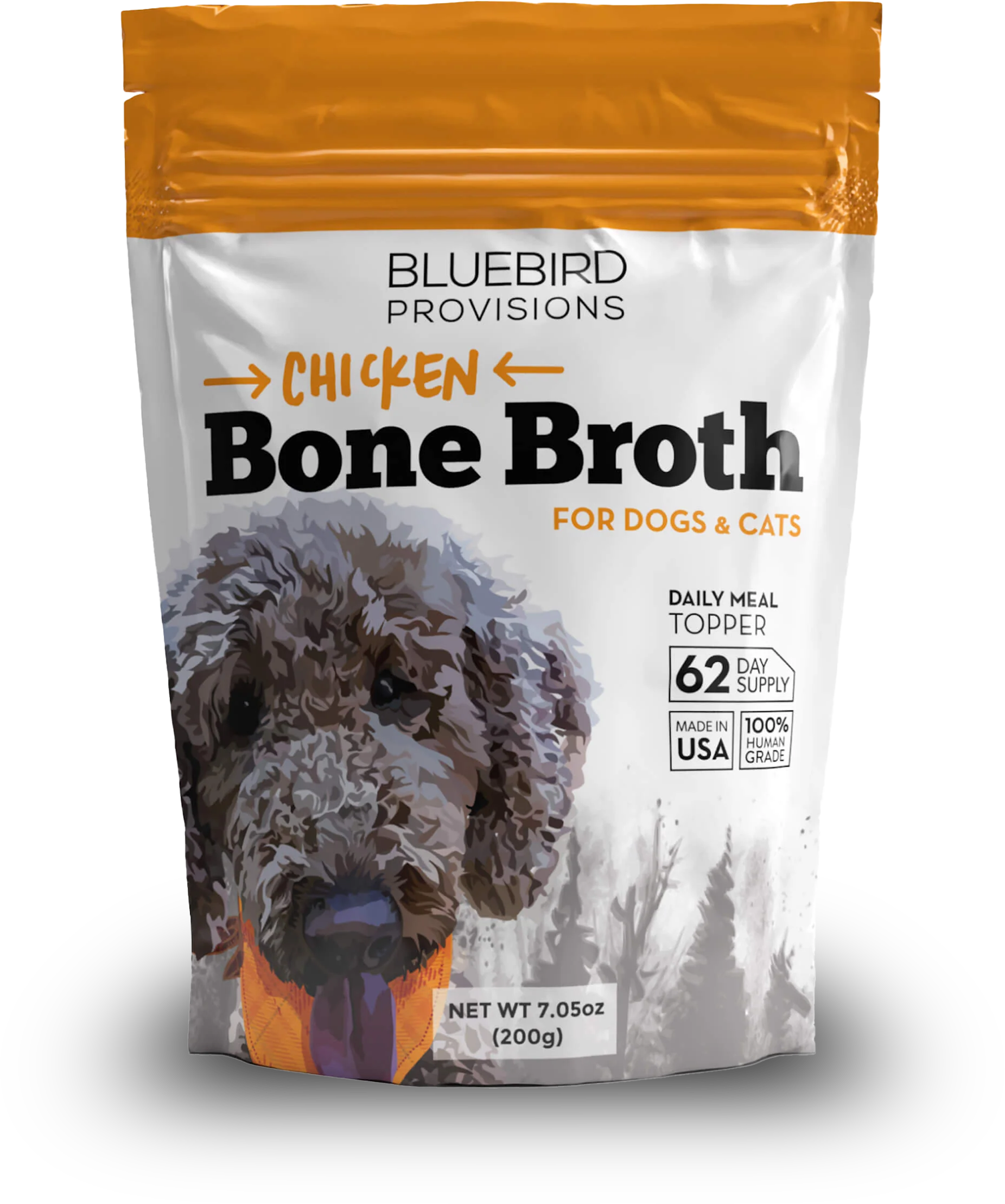
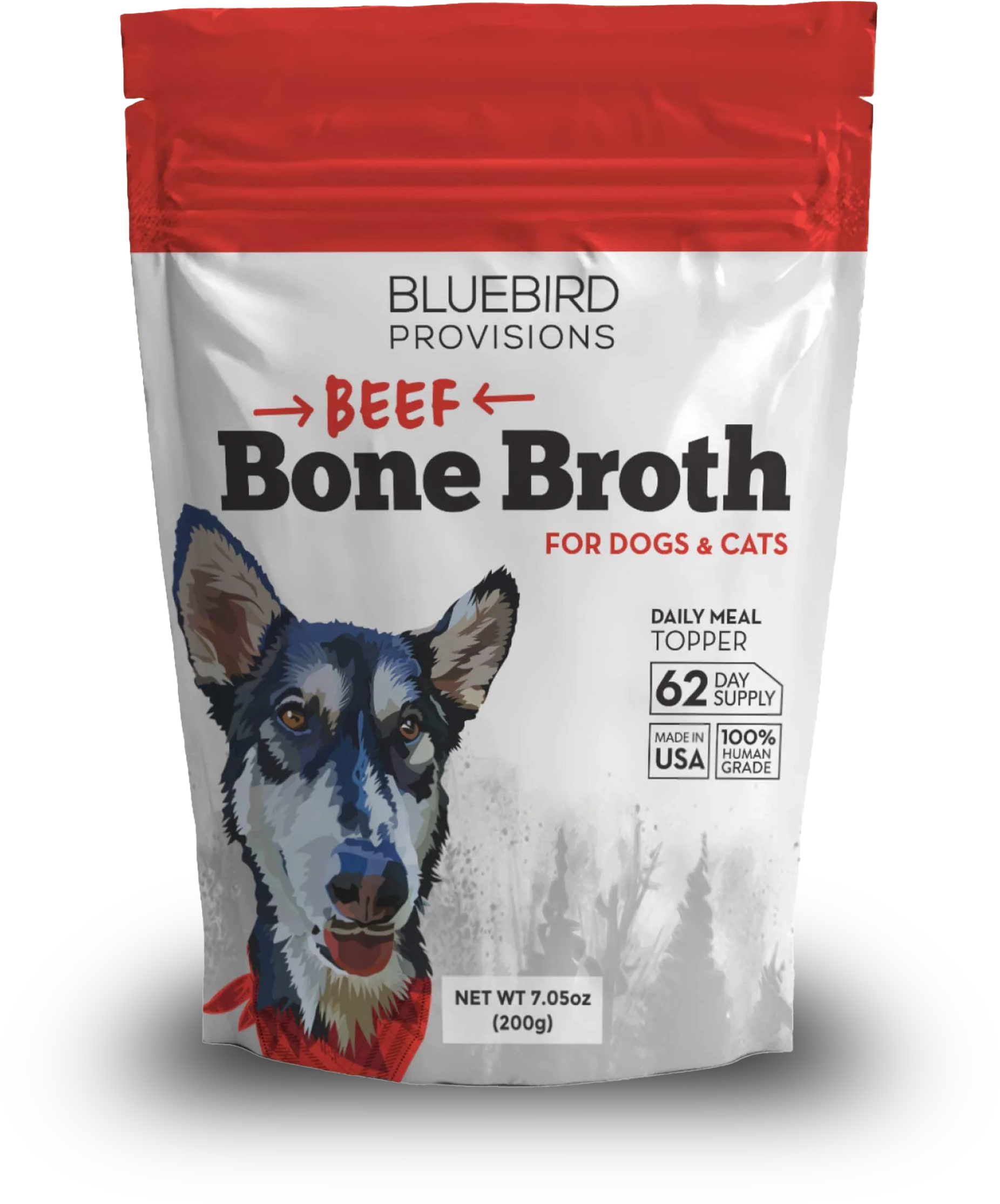

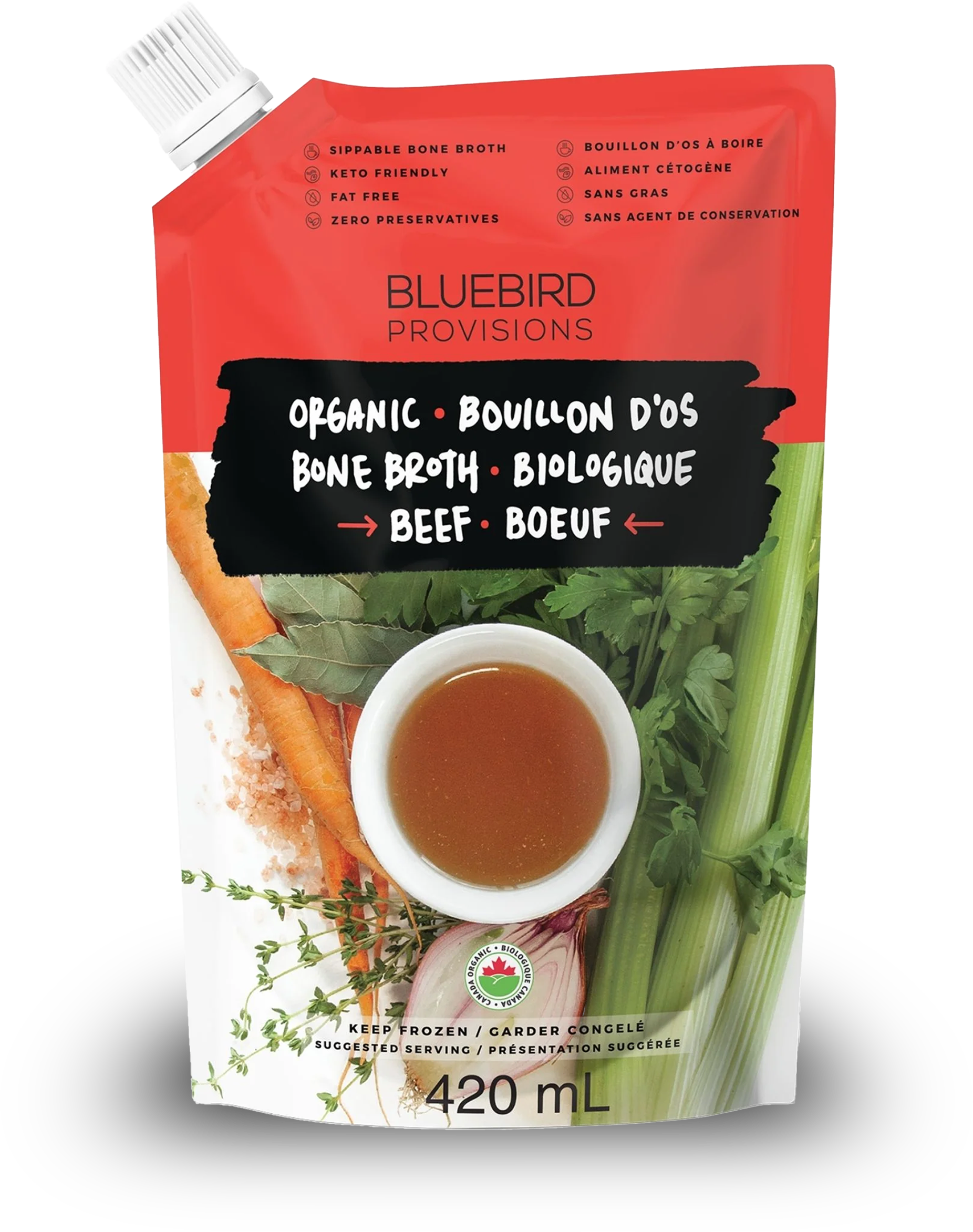






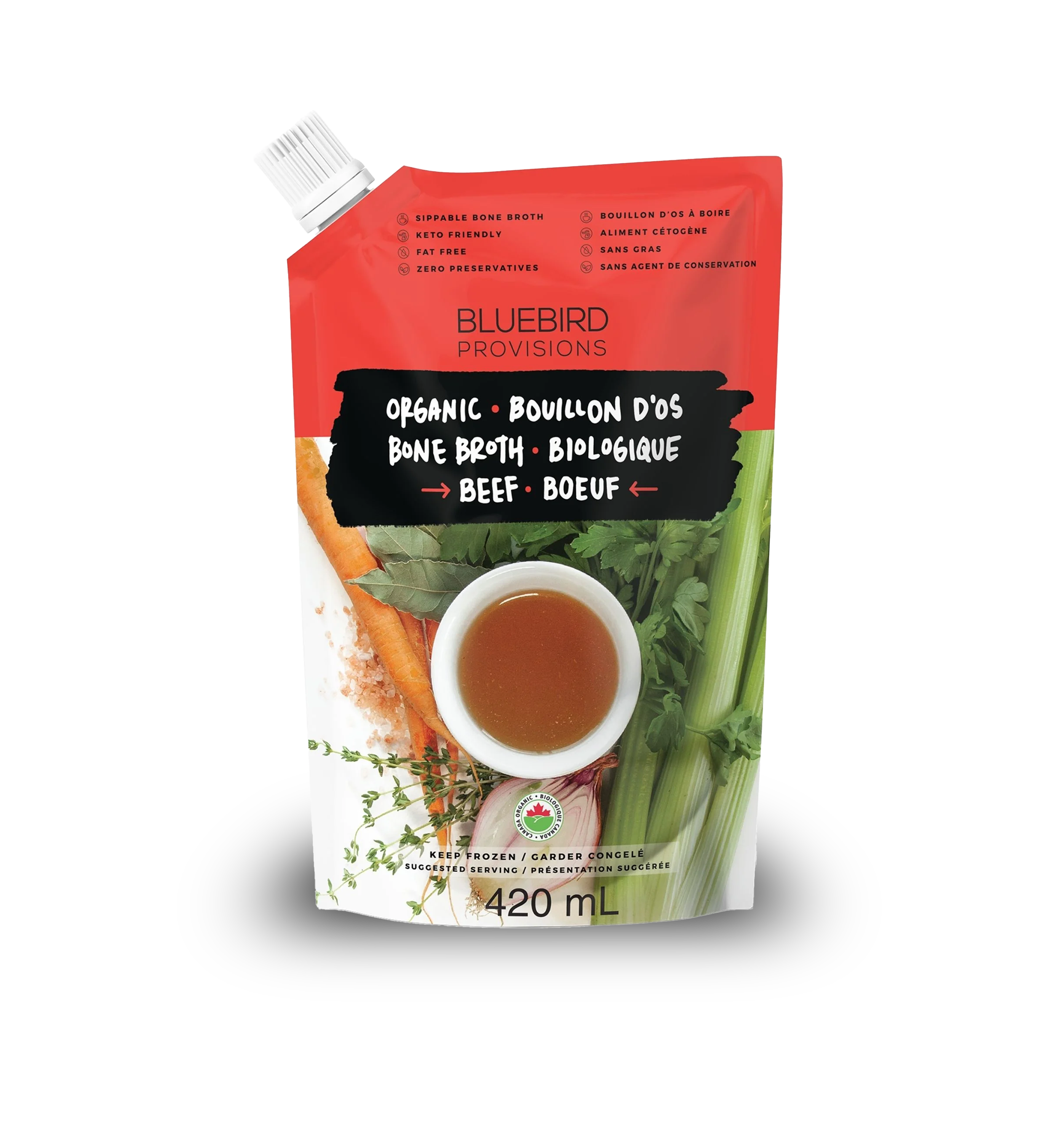

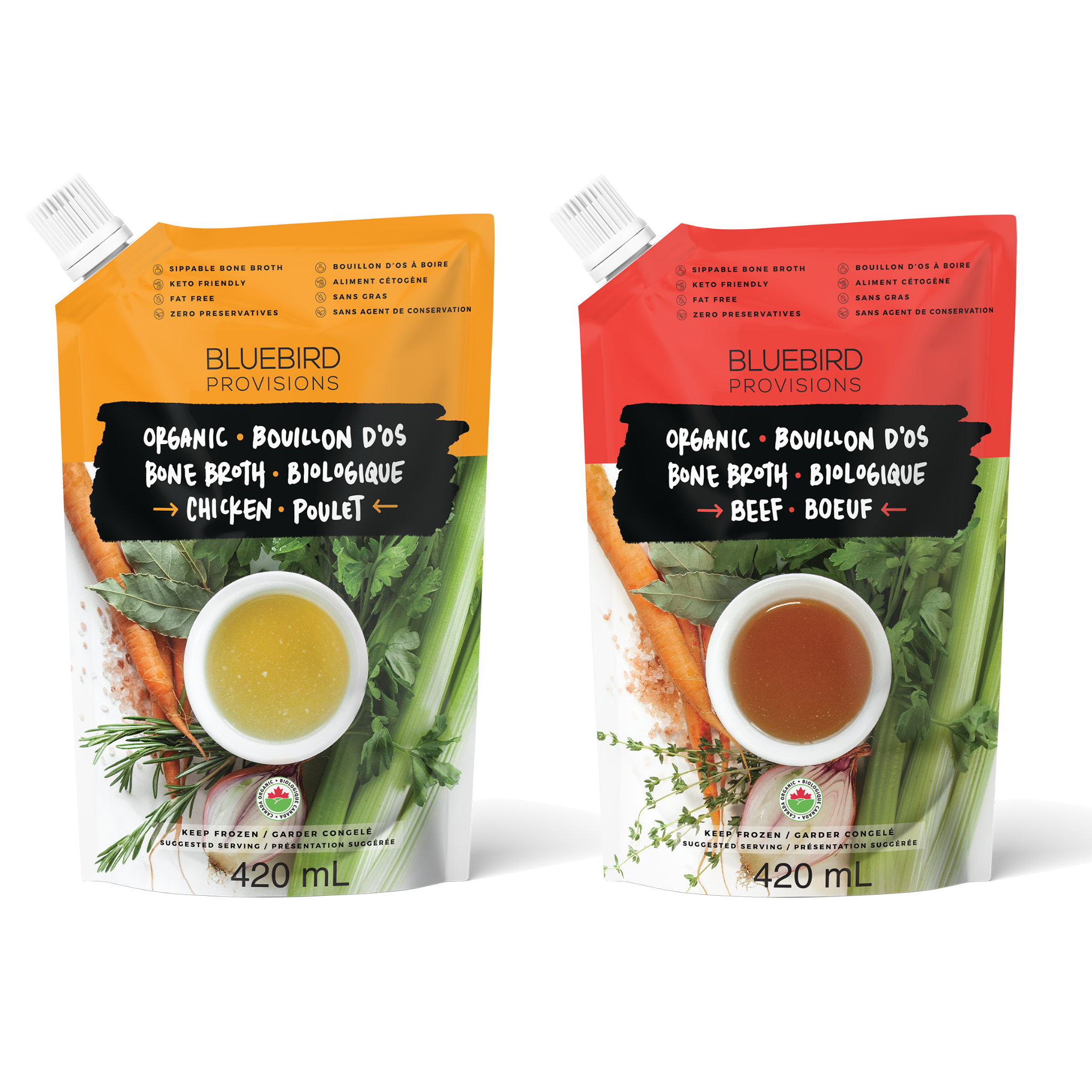

9 comments
This is in response to Nita. If you don’t want to eat the jelly liquid it is great for dogs , if you have one. I put it in ice cube trays, freeze it and give it to my mastiffs. One a day is good. Because they are so big I give them 2.
Vicki
Endless pompous unhelpful unnecessary verbiage.
Why do American bloggers have to write so much about something so basic??!
And make such a meal of everything?!
So pretentious.
You’re not the only one.
Take comfort from that.
Bored Out of my Mind
Hi Erica ,
With an instant pot, I generally recommend not skimming because of the hassle and issues with constantly having to open the pot. I’ve made really great bone broth without skimming in an instant pot.
You can double up the time for beef bones. But in my opinion, it is not necessary with chicken.
Roasting bones longer doesn’t really help that much. It is really about the cook time in the water that gives you the highest quality broth.
hope this helps!
Connor at Bluebird Provisions
Hi Connor, great info…thanks so much.
I have read several recipes all recommending the apple cider vinegar with you clearly state is not necessary and these recipes all say to be slow cooking for 24 to 48 hours and your recipe doesn’t say that I’m just curious about the benefits of roasting longer, and also using the Insta pot recommendations for 120 minutes And possibly doing that twice if you’re using the Insta pot you’re skipping the skimming step which you seem to think is very important. Can you advise on skimming and using the Insta pot?
Much Appreciated
Erica
So informative! Making it now!
Debbie
Hi Nita, yes the jelly liquid is very high protein broth, which is also delicious. I would not throw it out. IT is liquid gold.
And feet do give the best gelatin in bone broth. Use it if you can!
connor
Connor at Bluebird Provisions
Thank you so much for sharing this abundant information. I’ve obtained many tips from this article!!
Ashwini Vardhan
I have cooked chicken feet/paws and the liquid is very “jelly” like. Is this good to drink? I always throw it out. Also, if using the feet in the bone broth, will they give the broth a “gelatin” consistency?
Nita2
I love homemade broth
Arleen Kaizer
Leave a comment
This site is protected by hCaptcha and the hCaptcha Privacy Policy and Terms of Service apply.